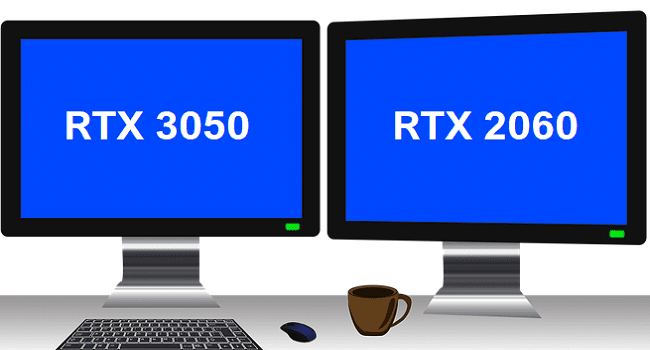This guide compares the Nvidia RTX 3050 and RTX 2060 graphics cards. We’ll list the main difference between them to help you decide which card is the right one for your needs.
RTX 3050 vs RTX 2060
Clock speed
The RTX 3050 has a 1,545 MHz clock base and you can boost it up to 1,780. The RTX 2060 has a 1,365 MHz base clock speed. You can overclock it up to 1,680 MHz.
Processing power
The RTX 2060 is better than the RTX 3050 in terms of processing power. It can process 10.483 TFLOPS in half-precision and you can boost it up to 12.902 TFLOPS.
The RTX 3050 can deliver 7.946 TFLOPS in half-precision format. You can boost it up to 9.098 TFLOPS.
If we’re talking ray tracing performance, RTX 2060 can deliver 25.2 TFLOPS TFLOPS when boosted, while the RTX 3050 can only deliver 18.2 TFLOPS.
FPS
According to benchmark tests, the RTX 2060 can deliver 114 FPS in lighting tests, 117 FPS in reflection tests, 134 FPS in rendering tests, and 101 FPS in particle system tests.
On the other hand, the RTX 3050 can deliver 103 FPS in lighting tests, 86.6 FPS in reflection tests, 84 FPS in rendering tests, and 73.4 FPS in particle system tests.
Ports
The RTX 2060 gives you more port options compared to its RTX 3050 counterpart. The RTX 3050 sports one HDMI 2.1 port and two DisplayPort 1.4a ports, while the RTX 2060 sports an additional DVI and a USB-C port.
RTX 3050 vs RTX 2060 specs
| Specs | 3050 | 2060 |
| NVIDIA CUDA Cores | 2560 / 2304 | 2176 / 1920 |
| Accelerated frequency (GHz) | 1,78 / 1,76 | 1,65 / 1,68 |
| Normal clock frequency (GHz) | 1,55 / 1,51 | 1,47 / 1,37 |
| Standard memory configuration | 8 GB GDDR6 | 12GB GDDR6 / 6GB GDDR6 |
| Memory interface width | 128-bit | 192-bit |
| Ray tracing cores | 2nd generation | 1nd generation |
| Tensor Cores | 3rd generation | 2nd generation |
| NVIDIA Architecture | Ampere | Turing |
| Microsoft DirectX 12 Ultimate | Yes | Yes |
| NVIDIA DLSS | Yes | Yes |
| NVIDIA Reflex | Yes | Yes |
| NVIDIA Broadcast | Yes | Yes |
| PCI Express Gen 4 | Yes | Yes |
| Resizable BAR | Yes | Yes |
| NVIDIA GeForce Experience | Yes | Yes |
| NVIDIA Ansel | Yes | Yes |
| NVIDIA Freestyle | Yes | Yes |
| NVIDIA ShadowPlay | Yes | Yes |
| NVIDIA Highlights | Yes | Yes |
| NVIDIA G-SYNC | Yes | Yes |
| Game Ready Controllers | Yes | Yes |
| NVIDIA Studio Drivers | Yes | Yes |
| NVIDIA Omniverse | Yes | Yes |
| NVIDIA GPU Boost | Yes | Yes |
| Vulkan RT API, OpenGL 4.6 | Yes | Yes |
| NVIDIA Encoder (NVENC) | 7nd generation | 7nd generation |
| NVIDIA Decoder (NVDEC) | 5nd generation | 4nd generation |
| CUDA Capacity | 8.6 | 7.5 |
| VR Ready | Yes | Yes |
Conclusion
The RTX 2060 marginally outperforms the RTX 3050 in terms of processing power, ray tracing capabilities, FPS, and connectivity. They’re both good 1080p cards but they’ll struggle at 1440p. However, the RTX 2060 performs better at higher settings than the RTX 3050.
If you’re building a PC, the RTX 2060 is the better option for most users. Its only weak point is the 6GB VRAM. You can tweak your resolution and graphics settings to use less VRAM and improve GPU performance. The 6 vs 8 GB VRAM difference doesn’t matter that much. At 1440P, 6GB should still be enough for most games.
However, when running graphically-demanding games at 1440p, you may need to play at low settings to get a stable frame rate on your RTX 2060 computer. As you scale up the resolution to 1440p, FPS will drop to 60 in most games.
If you’re planning to play the latest AAA games at the highest settings, consider buying a better GPU and adding more RAM.
References:
